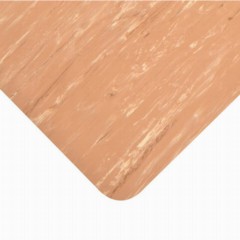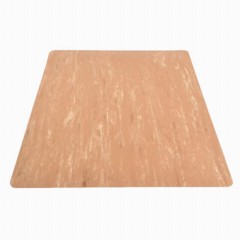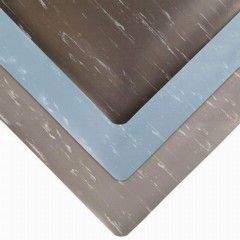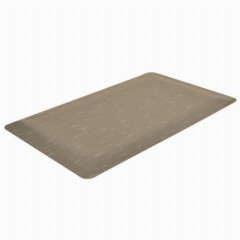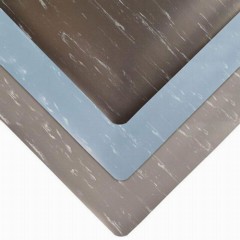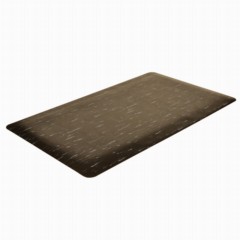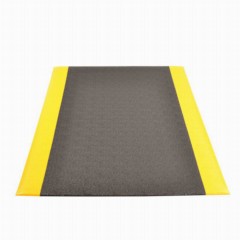Options for Ergonomic Flooring
Ergonomic flooring is a key option for providing safer conditions in an industrial workplace, commercial kitchen, office workstation, or workshop. The right ergo floor mats are ideal for creating a cushion for people who must stand and work.
When your feet are aching and your knees are sore, you can’t work as effectively. Our ergo flooring keeps workers comfortable. It’s still going to seem like a long time until 5 o’clock arrives, but at least you can watch the clock with comfortable flooring and less soreness.
Types and Styles of Ergonomic Floor Mats
We have many of the best ergonomic floor mats available. They offer slightly different properties in terms of design, installation, and benefits. They’re easy to clean and offer slip resistance.
Ergonomic work floor mats alone will not eliminate sore feet, but they can improve working conditions, especially when used in conjunction with the proper footwear. The design of the workstation also plays a big role in the amount of stress the body will endure.
We have straight-edge and interlocking anti-fatigue mats for industrial and residential use. Multiple materials are available to match the planned use case.
Polypropylene and Aluminum
The
Wearwell Foundation Platform System uses an aluminum frame to create a raised platform with polypropylene tiles over the top to deliver ergonomic benefits.
PVC and Foam
PVC and foam ergonomic flooring is wear- and tear-resistant. The
Airug Anti Fatigue Mat includes safety yellow-marked edges that protect people from trip hazards. The
SuperFoam Anti Fatigue Mat offers perforations that allow spilled liquid to drain away.
PVC and Vinyl
PVC and vinyl foam mats often feature raised patterns that encourage movement while providing traction. Our
Cushion Trax Ultra Anti Fatigue Mat includes both single-person mats and runners made for use along an assembly line. Our
Marble Tuff Anti-Fatigue Mat has a flat surface that resembles a marble floor for use in customer-facing areas.
Rubber
Rubber mats are extremely durable while providing just enough cushioning to maintain comfort for workers. Our
SaniTop Anti-Fatigue Rubber Mat has large and small perforations to speed up the drainage of liquids.
SkyStep ESD Rubber Anti Fatigue Mats provide protection against unwanted electrostatic discharge. Our interlocking
Performa Fatigue Mats have several different designs, some of which stand up to oil, grease, or water.
Our
Pacific Rolled Rubber flooring covers a large space for a reasonable price. We also offer
Pacific Rubber Interlocking Tiles when you need to cover a specific-sized space.
PVC Plastic
PVC plastic is among the most popular materials we offer for ergonomic flooring.
We have interlocking tiles that are easy to install. Our
Perforated Safety Matta Tiles use a combination of a non-slip tread and perforations to reduce the slip risk when people are working in wet conditions. Our
Bump Top StayLock Tile has a bubble surface texture that enhances comfort during working hours or workouts.
Wearwell ErgoDeck Solid Tiles offer several surface texture patterns so you can match the planned usage for the tiles.
Our PVC plastic rolls are proven successful in industrial settings where you need to cover large areas. Our
Vynagrip Heavy Duty Industrial Matting contours to uneven surfaces while maintaining slip resistance.
Heronair Industrial Matting includes a hollow cushioned surface to maximize comfort along an assembly line or walkway.
Cork and Rubber
Our
FlexeCork Interlocking Tiles feature a blend of cork and rubber materials that delivers an interesting pattern and maximum cushioning and durability.
Ergonomic Flooring Features and Benefits
Some of the key benefits of our ergonomic floor matting include:
- Reduced stress on hips, legs, and ankles
- Improved employee health and productivity
- Soft surface encourages slight movement throughout the workday that improves blood circulation
- Reduced slips and falls, thanks to excellent traction
- A safer, more comfortable workplace environment
Ergonomic Mat Use Types
Our ergo mats for industrial use have many different potential use types, including:
- Trade show booths
- Small engine workshops
- Woodworking spaces
- Pool decks
- Outdoor event spaces
- Entryways
- Home office
- Kitchens
- Weight rooms
- Home gyms
- Office workstations
- Industrial workplaces
Ergonomic Flooring Q&A
How do you choose the best ergonomic floor mats?
Choosing the best ergonomic floor mats requires understanding the needs of the people who will be using them. The mats should not be too soft or firm. They should encourage subtle muscle movement to enhance blood flow and to keep the effects of lower body muscle fatigue at bay.
What are the differences among ergonomic mats?
The primary
differences among ergonomic mats include the materials they use, such as PVC plastic, a rubber-foam blend, or rubber. They may feature different raised surface textures to encourage leg movement while providing anti fatigue benefits.
What type of pressure relief mat is best over concrete?
The
best type of pressure relief mat for use over concrete should deliver moisture resistance because moisture can seep through concrete. The material in the mat should reduce pain and discomfort in the hips, knees, and ankles. The
Diamond Deluxe Soft Foot Mat is one of our most popular options.
How thick are anti fatigue floor mats?
The
thickness for anti fatigue floor mats can range from 1/8 of an inch to 1 inch. Additional thicknesses outside this range are available, but these measurements are the most popular. Thinner mats appear in large coverage sizes for walkways, while thicker mats are best for use in front of workstations.
What are the top 5 basement floor choices for fatigue relief?
The
top-rated basement floors for fatigue relief should consist of heavy-duty materials that can stand up to the moisture that sometimes seeps through the concrete in a foundation. They’ll provide a more comfortable surface for people compared to standing on concrete alone.
 $19209 /Mat You Save 2%$12.81/sqftShop$2,59321 /Mat You Save 2%$11.53/sqftShop$3,45762 /Mat You Save 3%$11.53/sqftShop$12298 /Mat You Save 2%$20.50/sqftShop$2,40582 /Mat You Save 3%$16.04/sqftShop$64155 /Mat You Save 2%$17.82/sqftShop$26732 /Mat You Save 3%$17.82/sqftShop$3,60873 /Mat You Save 2%$16.04/sqftShop$4,81165 /Mat You Save 2%$16.04/sqftShop$3590 /Mat You Save 2%$5.98/sqftShop$7179 /Mat You Save 2%$5.98/sqftShop$64608 /Mat You Save 2%$5.38/sqftShop$21536 /Mat You Save 2%$5.98/sqftShop$8973 /Mat You Save 3%$5.98/sqftShop$10767 /Mat You Save 2%$5.98/sqftShop$96910 /Mat You Save 2%$5.38/sqftShop
$19209 /Mat You Save 2%$12.81/sqftShop$2,59321 /Mat You Save 2%$11.53/sqftShop$3,45762 /Mat You Save 3%$11.53/sqftShop$12298 /Mat You Save 2%$20.50/sqftShop$2,40582 /Mat You Save 3%$16.04/sqftShop$64155 /Mat You Save 2%$17.82/sqftShop$26732 /Mat You Save 3%$17.82/sqftShop$3,60873 /Mat You Save 2%$16.04/sqftShop$4,81165 /Mat You Save 2%$16.04/sqftShop$3590 /Mat You Save 2%$5.98/sqftShop$7179 /Mat You Save 2%$5.98/sqftShop$64608 /Mat You Save 2%$5.38/sqftShop$21536 /Mat You Save 2%$5.98/sqftShop$8973 /Mat You Save 3%$5.98/sqftShop$10767 /Mat You Save 2%$5.98/sqftShop$96910 /Mat You Save 2%$5.38/sqftShop



